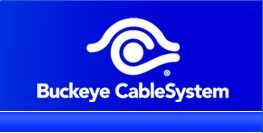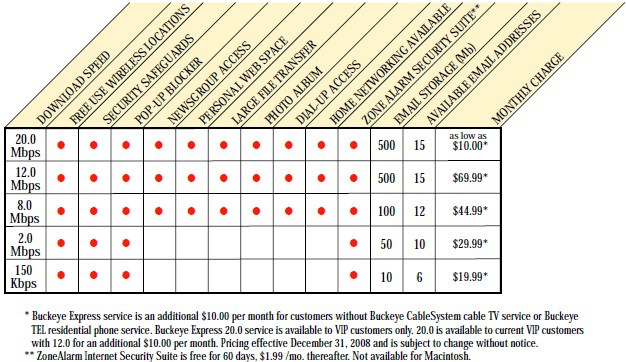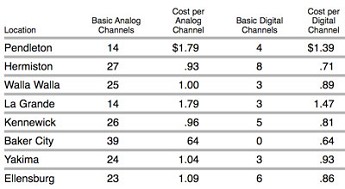AT&T Mobility wanted Verizon Wireless to stop showing ads that call out the differences between the two wireless competitors’ national 3G networks. When Verizon didn’t, AT&T sued. This week Verizon Wireless doubles down with three new holiday season ads that are guaranteed to enrage AT&T even further.
Anyone who has seen a Rankin/Bass holiday special will instantly recognize at least one of the ads is a play on the Island of Misfit Toys, seen in the 1964 holiday classic Rudolph, the Red-Nosed Reindeer.
[flv width=”620″ height=”380″]http://www.phillipdampier.com/video/Verizon Wireless Verizon Misfit Toys Ad.flv[/flv]
Verizon Wireless – “The Island of Misfit Toys” (30 seconds)
AT&T accuses Verizon Wireless of misrepresenting its national data coverage by showing non-3G areas in white, a color AT&T says traditionally represents no service at all. AT&T says its wireless data network, in its entirety, is more expansive than Verizon’s. Verizon counters its ads only compare 3G coverage, and clearly label the maps as such, including a fine print disclaimer indicating “voice and data services available outside 3G coverage area.”
AT&T further argues watching frustrated consumers shaking their phones or sitting alone because they were unable to meet up with their friends would suggest to a casual viewer they weren’t able to access any service.
[flv width=”620″ height=”380″]http://www.phillipdampier.com/video/Verizon Wireless Blue Christmas Ad.flv[/flv]
Verizon Wireless – “Blue Christmas” is sure to draw the ire of AT&T as a frustrated father visibly shakes his iPhone and never seems to be able to use it. (30 seconds)
Verizon Wireless’ attorneys officially responded to the AT&T request for a temporary restraining order to pull the ads off the air with a direct opening: “AT&T did not file this lawsuit because Verizon’s ‘There’s A Map For That’ advertisements are untrue; AT&T sued because Verizon’s ads are true and the truth hurts.”
The attorneys argue, “Remarkably, AT&T admits that the 3G coverage maps — the one thing that is common to all five ads — are accurate and that the ads’ express statement that Verizon has ‘5X More 3G Coverage’ than AT&T is true.”
AT&T has been one of the loudest voices in this advertising battle, spending many millions of dollars to market its 3G network as the “Nation’s Fastest 3G Network” and, with its exclusive partner Apple, naming the latest iPhone (only available on AT&T’s network) the “iPhone 3GS.”
The stark truth, as revealed by the concededly accurate coverage maps in Verizon’s advertising, is that the geographic reach of AT&T’s 3G network is far less extensive than AT&T would have the public believe — and far less extensive than Verizon’s 3G network. Consumers who are interested in smartphones have a strong interest in knowing the comparative 3G coverage offered by Verizon and AT&T. Cutting off the free flow of information about Verizon’s more extensive 3G coverage would harm consumers in a way that could not be redressed. And because injury to First Amendment rights is by definition irreparable, suppressing Verizon’s speech on an “emergency” basis before a definitive and fair adjudication would irreparably injure Verizon and its goodwill in addition to costing Verizon customers. Any harm to AT&T, in contrast, is merely speculative.
In the final analysis, AT&T seeks emergency relief because Verizon’s side-by-side, apples-to-apples comparison of its own 3G coverage with AT&T’s confirms what the marketplace has been saying for months: AT&T failed to invest adequately in the necessary infrastructure to expand its 3G coverage to support its growth in smartphone business, and the usefulness of its service to smartphone users has suffered accordingly. AT&T may not like the message that the ads send, but this Court should reject its efforts to silence the messenger.
[flv width=”620″ height=”380″]http://www.phillipdampier.com/video/Verizon Wireless Elves Ad.flv[/flv]
Verizon Wireless – “Elves” includes the line “good luck browsing the web with that one.” (30 seconds)
AT&T has gone all out to find confused consumers to back up their request for a temporary restraining order, running a survey asking ordinary cell phone users what they thought Verizon Wireless’ ads meant. But Verizon Wireless answers the survey wasn’t limited to smartphone customers, who are already well aware of the differences between 3G and older, slower speed data networks, and for that reason the results are invalid.
Verizon Wireless says it will continue the aggressive campaign beyond the all-important holiday season, when cell phone handset sales are at some of their highest traditional levels.


 Subscribe
Subscribe






